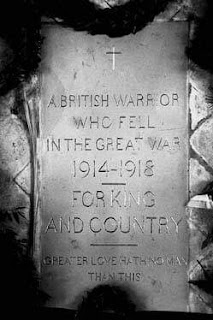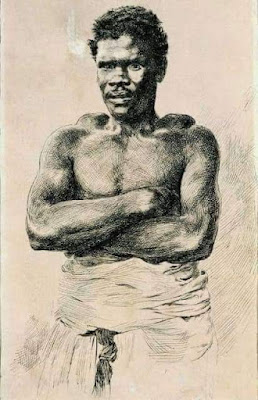BENEATH THIS STONE RESTS THE BODY OF A BRITISH WARRIOR UNKNOWN BY NAME OR RANK
At the west end of the Nave of Westminster Abbey is the grave of the Unknown Warrior, whose body was brought from France to be buried here on 11 November 1920. The grave, which contains soil from France, is covered by a slab of black Belgian marble from a quarry near Namur. On it is the following inscription, composed by Herbert Ryle, Dean of Westminster:
BENEATH THIS STONE RESTS THE BODY
OF A BRITISH WARRIOR
UNKNOWN BY NAME OR RANK
BROUGHT FROM FRANCE TO LIE AMONG
THE MOST ILLUSTRIOUS OF THE LAND
AND BURIED HERE ON ARMISTICE DAY
11 NOV: 1920, IN THE PRESENCE OF
HIS MAJESTY KING GEORGE V
HIS MINISTERS OF STATE
THE CHIEFS OF HIS FORCES
AND A VAST CONCOURSE OF THE NATION
THUS ARE COMMEMORATED THE MANY
MULTITUDES WHO DURING THE GREAT
WAR OF 1914-1918 GAVE THE MOST THAT
MAN CAN GIVE LIFE ITSELF
FOR GOD
FOR KING AND COUNTRY
FOR LOVED ONES HOME AND EMPIRE
FOR THE SACRED CAUSE OF JUSTICE AND
THE FREEDOM OF THE WORLD
THEY BURIED HIM AMONG THE KINGS BECAUSE HE
HAD DONE GOOD TOWARD GOD AND TOWARD
HIS HOUSE
Around the main inscription are four texts:
(top) THE LORD KNOWETH THEM THAT ARE HIS,
(sides) GREATER LOVE HATH NO MAN THAN THIS
UNKNOWN AND YET WELL KNOWN, DYING AND BEHOLD WE LIVE,
(base) IN CHRIST SHALL ALL BE MADE ALIVE.
Selecting the Unknown Warrior.
The idea of such a burial seems first to have come to a chaplain at the Front, the Reverend David Railton (1884-1955), when he noticed in 1916 in a back garden at Armentières, a grave with a rough cross on which were pencilled the words "An Unknown British Soldier". In August 1920 he wrote to the Dean of Westminster, Herbert Ryle, through whose energies this memorial was carried into effect. The body was chosen from unknown British servicemen exhumed from four battle areas, the Aisne, the Somme, Arras and Ypres. (some sources say six bodies but confirmed accounts say four). The remains were brought to the chapel at St. Pol on the night of 7 November 1920. The General Officer in charge of troops in France and Flanders, Brigadier General L.J.Wyatt, with Colonel Gell, went into the chapel alone, where the bodies on stretchers were covered by Union Flags. They had no idea from which area the bodies had come. General Wyatt selected one and the two officers placed it in a plain coffin and sealed it. The other three bodies were reburied. General Wyatt said they were re-buried at the St Pol cemetery but Lt.(later Major General Sir) Cecil Smith says they were buried beside the Albert-Baupaume road to be be discovered there by parties searching for bodies in the area.
In the morning Chaplains of the Church of England, the Roman Catholic Church and Non-Conformist churches held a service in the chapel before the body was escorted to Boulogne to rest overnight. The next day the coffin was placed inside another which had been sent over specially from England made of two-inch thick oak from a tree which had grown in Hampton Court Palace garden, lined with zinc. It was covered with the flag that David Railton had used as an altar cloth during the War (known as the Ypres or Padre's Flag, which now hangs in St George's Chapel). Within the wrought iron bands of this coffin had been placed a 16th century crusader's sword from the Tower of London collection. The inner coffin shell was made by Walter Jackson of the firm of Ingall, Parsons & Clive Forward at Harrow, north London and the larger coffin was supplied by the undertakers in charge of the arrangements, Nodes & Son. The coffin plate bore the inscription:
"A British Warrior who fell in the Great War 1914-1918 for King and Country".
The ironwork and coffin plate were made by D.J.Williams of the Brunswick Ironworks at Caernarfon in Wales. The destroyer HMS Verdun, whose ship's bell was presented to the Abbey and now hangs near the grave, transported the coffin to Dover and it was then taken by train to Victoria station in London where it rested overnight.
The burial
On the morning of 11 November the coffin was placed on a gun carriage drawn by six black horses and began its journey through the crowd-lined streets, making its first stop in Whitehall where the Cenotaph was unveiled by King George V. The King placed his wreath of red roses and bay leaves on the coffin. His card read "In proud memory of those Warriors who died unknown in the Great War. Unknown, and yet well-known; as dying, and behold they live. George R.I. November 11th 1920". Then the carriage, with pall bearers (Admirals) Lord Beatty, Sir Hedworth Meux, Sir Henry Jackson, Sir C.E.Madden, (Field Marshals) Lord French, Lord Haig, Lord Methuen, Sir Henry Wilson, (Generals) Lord Horne, Lord Byng, Albert Farrar-Gatliff and Air Chief Marshal Sir Hugh Trenchard, followed by the King, members of the Royal Family and ministers of State, made its way to the north door of Westminster Abbey.
Inside the Choir sang, unaccompanied, "O Valiant Hearts" (to the tune Ellers). The coffin was borne to the west end of the Nave through a guard of honour of 100 holders of the Victoria Cross, under the command of Colonel Freyburg VC. During the shortened form of the Burial Service, after the hymn "Lead kindly light", the King stepped forward and dropped a handful of French earth onto the coffin as it was lowered into the grave. At the close of the service, after the hymn "Abide with me" and prayers, the congregation sang Rudyard Kipling's solemn Recessional "God of our fathers" (to the tune Melita), after which the Reveille was sounded by trumpeters. Other eminent members of the congregation were Queen Alexandra, the queens of Spain and Norway, the Duke of Connaught, politicians Lloyd George and Asquith, and Sir Douglas Dawson.
The grave was then covered by a silk funeral pall, which had been presented to the Abbey by the Actors' Church Union in memory of their fallen comrades, with the Padre's flag lying over this. Servicemen kept watch while thousands of mourners filed past. Special permission had been given to make a recording of the service but only the two hymns were of good enough quality to be included on the record, the first electrical recording ever to be sold to the public.
The grave was filled in, using 100 sandbags of earth from the battlefields, on 18 November and then covered by a temporary stone with a gilded inscription on it:
"A BRITISH WARRIOR WHO FELL IN THE GREAT WAR 1914-1918 FOR KING AND COUNTRY. GREATER LOVE HATH NO MAN THAN THIS."
New stone and the Congressional Medal
On 11 November 1921 the present black marble stone was unveiled at a special service. The stone (size 7 feet by 4 feet 3 inches, depth 6 inches) was supplied and lettered by Mr Tomes of Acton and the brass for the inscription supplied by Nash & Hull. Benjamin Colson carried out the brass work. The Padre's Flag was also formerly dedicated at this service.
General Pershing, on behalf of the United States of America, conferred the Congressional Medal of Honor on the Unknown Warrior on 17 October 1921 and this now hangs in a frame on a pillar near the grave. In October 2013 the Congressional Medal of Honor Society presented the Society's official flag to the Unknown Warrior and this is framed below the medal.
The body of the Unknown Warrior may be from any of the three services, Army, Navy or Air Force, and from any part of the British Isles, Dominions or Colonies and represents all those who died who have no other memorial or known grave.
When the Duke of York (later King George VI) married Lady Elizabeth Bowes Lyon in the Abbey in 1923 as she left she laid her wedding bouquet on the grave as a mark of respect (she had lost a brother during the war). All royal brides married in the Abbey since then have sent back their bouquets to be laid on the grave.
Padre's Flag.
A bronze plaque on a pillar outside St George's chapel concerns the Padre's Flag:
"This Union Jack sometimes called the Padre's Flag was used day by day on flag post on improvised altar or as a covering for the fallen on the Western Front during the Great War 1914-1918. It covered the coffin of the Unknown Warrior at his funeral on November 11th 1920. After resting for a year on the grave it was presented to the Abbey Church of Westminster on Armistice Day 1921 by the chaplain who used it during the war and was dedicated on the High Altar "To the glory of God and in perpetual memory of all who gave their lives fighting by land and sea and air for their King, for Great Britain and Ireland and for the Dominions beyond the seas".
The flag was hoisted onto the pillar above the grave at the dedication service. Company Sgt.Major Harry Evans, a soldier from the 17th London Division climbed a tall ladder to fix the flag, with the 5th brigade of the 47th London Division looking on. It remained there for many years before being moved to hang in St George's chapel. Before being presented to the Abbey the flag had been cleaned so there are no bloodstains on it.
David Railton
David Railton was born on 13 November 1884 at Leytonstone in London. He received the Military Cross in 1916 for saving an officer and two men under heavy fire. After the war he became Vicar of St John's church at Margate in Kent. He was killed in an accidental fall from a train in Scotland in June 1955.
H.M.S.Verdun bell
The plate below the bell (which is inscribed H.M.S.Verdun 1917) reads:
"The bell of H.M.S. Verdun in which the Unknown Warrior was brought from Boulogne to Dover on the eve of Armistice Day 1920. Presented by Cdr. J.D.R. Davies, M.B.E., R.N. Remembrance Sunday 1990"
Field of Remembrance
The annual Field of Remembrance outside the Abbey was started in 1928 by Major George Howson M.C., founder of the British Legion Poppy Factory. He and a few disabled ex-servicemen stood together around a battlefield cross with trays of paper poppies to sell to passers by who could then plant one beside the cross to remember the fallen.
The Legion organizes the much expanded plot each year and all proceeds go to their poppy appeal for veterans. In recent years the late Queen Mother and the Duke of Edinburgh have most often attended the opening ceremony. Prince Harry attended in 2014. The familiar words spoken at the dedication of the Field are from Laurence Binyon's poem "For the Fallen" - "They shall grow not old, as we that are left grow old: Age shall not weary them, nor the years condemn. At the going down of the sun, and in the morning, we will remember them."











Comments
Post a Comment